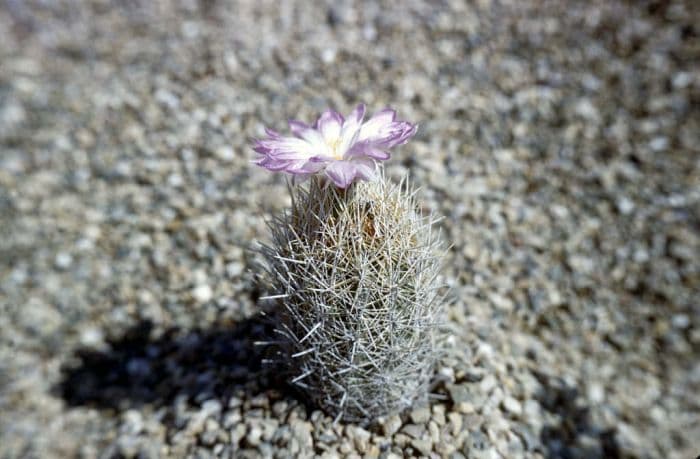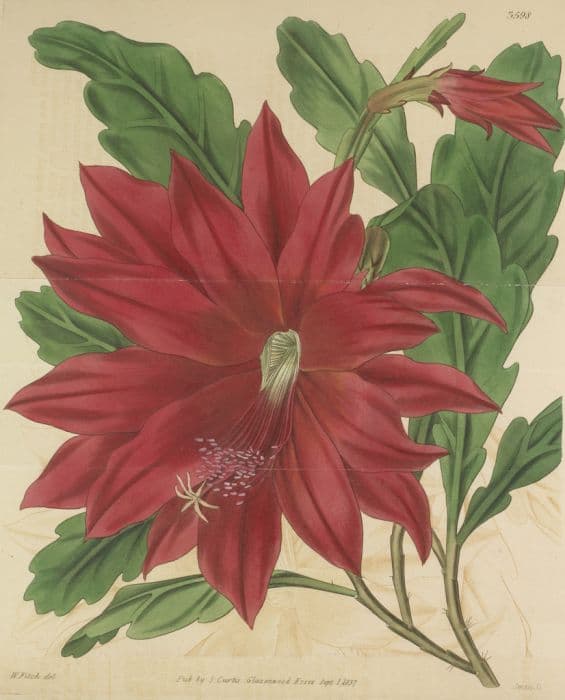Glory of Texas Thelocactus bicolor

ABOUT
Thelocactus bicolor, commonly known as the Glory of Texas, is a spherical to columnar cactus with a green to blue-green body that is segmented into numerous ribs. These ribs are adorned with white areoles from which emerge clusters of spines. The spines can range in color from white and yellow to red, often with darker tips, forming a striking contrast with the body of the cactus. This plant produces large, funnel-shaped flowers in vibrant shades of pink to magenta with contrasting white or yellow throats. The flowers emerge near the top of the plant and can be quite showy. After the flowering season, the Glory of Texas may produce fruits that are elongated and bear small scales, which later dry and release seeds.
About this plant
 Names
NamesFamily
Cactaceae.
Synonyms
Glory Of Texas, Texas Thelocactus, Bicolor Thelocactus, Variegated Cactus.
Common names
Echinocactus bicolor, Hamatocactus bicolor, Thelocactus bicolor var. bolaensis, Thelocactus bicolor var. flavidispinus, Thelocactus bicolor var. schwarzii, Thelocactus bicolor var. tricolor, Thelocactus multicolor, Thelocactus schwarzii.
 Toxicity
ToxicityTo humans
The Thelocactus bicolor, commonly known as Glen Rose cactus, is not known to be toxic to humans. There are no well-documented cases of poisoning from ingesting this plant, nor are there common symptoms associated with toxicity from this cactus. However, like with any non-edible plant, ingesting parts of the Glen Rose cactus is not advisable, and sensitive individuals may experience mild gastrointestinal upset or an allergic reaction.
To pets
The Glen Rose cactus is not known to be toxic to pets either. This generally means that if a pet were to ingest parts of the plant, it should not result in poisoning or display symptoms associated with toxicity. Nevertheless, as a safety precaution and due to the possibility of mechanical injury from the spines, it is best to keep the cactus out of reach from pets. If a pet does ingest parts of the cactus, it could potentially lead to gastrointestinal issues due to the plant’s fibrous material, and there is also a risk of injury from the spines.
 Characteristics
CharacteristicsLife cycle
Perennials
Foliage type
Evergreen
Color of leaves
Green
Flower color
Pink
Height
6 inches (15 cm)
Spread
6 inches (15 cm)
Plant type
Cactus
Hardiness zones
9
Native area
Mexico
Benefits
 General Benefits
General Benefits- Low Maintenance: Thelocactus bicolor, commonly known as Glory of Texas, is relatively easy to care for and does not require frequent watering or intricate care routines.
- Drought Tolerant: Being a cactus, it's well-suited to arid environments and can survive prolonged periods without water.
- Decorative Appeal: With its colorful, striking appearance, Glory of Texas adds aesthetic value to gardens and indoor spaces.
- Adaptability: It can thrive in a variety of conditions, which makes it suitable for different settings, from rock gardens to indoor plant collections.
- Educational Interest: As an example of a desert plant, it can be used for educational purposes to teach about plant adaptations and ecosystems.
- Propagation: Thelocactus bicolor can be easily propagated from seeds or offsets, making it simple for enthusiasts to expand their collection.
- Habitat Support: When planted outdoors in suitable regions, it can provide habitat and resources for native wildlife, including pollinators.
 Medical Properties
Medical PropertiesThis plant is not used for medical purposes.
 Air-purifying Qualities
Air-purifying QualitiesThis plant is not specifically known for air purifying qualities.
 Other Uses
Other Uses- Thelocactus bicolor, commonly known as the Glory of Texas, can be employed as a natural barrier or fence due to its spiny exterior, which can deter animals and unauthorized access to private properties.
- The striking appearance of the Glory of Texas makes it a popular choice for rock gardens, adding a unique aesthetic and blending well with other drought-tolerant plants.
- The plant's resilient nature allows it to be used in xeriscaping, which is a landscaping method that reduces or eliminates the need for irrigation.
- Enthusiasts of the Glory of Texas might use its seeds for trading with other cactus aficionados, as part of a hobbyist network of plant exchange.
- Due to its compact size, the plant is well-suited for use in educational settings, such as schools or botanical studies, to teach students about desert flora and adaptation strategies.
- Because of its vibrant flower, photographers and artists may use the Glory of Texas as a subject in their work to showcase the beauty of desert plants.
- This cactus can also be planted as part of reforestation efforts in arid regions where its hardiness makes it an asset in combating desertification.
- The plant may be utilized in traditional ceremonies or cultural practices by indigenous groups who live in areas where it naturally occurs.
- Specialist nurseries often cultivate Thelocactus bicolor as a collectible item, catering to enthusiasts who appreciate its rare and colorful blooms.
- Some individuals may cultivate the Glory of Texas for the challenge, as growing and nurturing cacti can test a gardener's skills due to their unique growing requirements.
Interesting Facts
 Feng Shui
Feng ShuiThe Thelocactus bicolor, commonly known as Glory of Texas, is not used in Feng Shui practice.
 Zodiac Sign Compitability
Zodiac Sign CompitabilityThe Glory of Texas is not used in astrology practice.
 Plant Symbolism
Plant Symbolism- Resilience – The Thelocactus bicolor, known as the Glory of Texas, is symbolic for resilience as it thrives in harsh desert conditions, surviving where few plants can.
- Beauty and Contrast – With its brilliant pink flowers contrasting against its spiny, tough exterior, this cactus represents beauty and contrast, reminding us that beauty often exists amidst harshness.
- Adaptability – This plant is adept at adapting to scarce water and nutrient supplies, symbolizing the ability to adapt to challenging environments and situations.
- Protection – The spines of the Glory of Texas serve as a natural protection mechanism, symbolizing the need for boundaries and self-defense.
- Endurance – This cactus has the ability to endure extreme temperatures and drought, making it a symbol of endurance and the ability to withstand tough times.
 Water
WaterThe Thelocactus bicolor, commonly known as the Glory of Texas, should be watered thoroughly but infrequently. During the growing season in spring and summer, water the plant every 7 to 10 days, giving enough water so that it runs through the drainage holes—typically about 8 to 12 onzes per watering session, depending on the size of the pot. In winter, reduce watering to once a month, as the plant enters a dormant period and needs significantly less moisture. Always allow the soil to dry out completely between waterings to prevent root rot.
 Light
LightFor the Glory of Texas, it thrives under bright, direct sunlight. The ideal spot for this plant is a south-facing window where it can receive at least six hours of sunlight a day. However, during the peak of summer, it may be beneficial to provide some afternoon shade to protect the plant from excessive heat and intense sun rays.
 Temperature
TemperatureThe Glory of Texas prefers temperatures between 70°F and 85°F but can tolerate a range from 50°F to 90°F. It is not frost-tolerant, so if you have it outdoors, be sure to bring it inside or provide protection when temperatures are expected to drop below 50°F. The plant's ideal temperature range promotes healthy growth and flowering.
 Pruning
PruningPruning is generally not required for the Glory of Texas, as it is a slow-growing cactus. However, any dead or damaged spines or flowers can be gently removed to maintain the plant's appearance. The best time for this minimal pruning is in spring before the new growth begins, ensuring the plant stays healthy and attractive.
 Cleaning
CleaningAs needed
 Soil
SoilThe best soil mix for the Glen Rose cactus should be well-draining and gritty. A mixture of coarse sand, perlite, and potting soil in equal parts is suitable. Maintain soil pH between 6.0 and 7.5 for optimal growth.
 Repotting
RepottingGlen Rose cacti should be repotted every 2-3 years. It's best to repot in spring or summer when the plant is actively growing.
 Humidity & Misting
Humidity & MistingGlen Rose cacti prefer low humidity environments, typical to arid habitats.
 Suitable locations
Suitable locationsIndoor
Place Glen Rose cactus in bright light, allow soil to dry between waterings.
Outdoor
Full sun or light shade, well-draining soil, protect from heavy rains.
Hardiness zone
9-11 USDA
 Life cycle
Life cycleThe life of the Thelocactus bicolor, commonly known as the glory of Texas, begins with seed germination, which occurs when environmental conditions such as temperature and moisture are suitable. After germination, a tiny seedling emerges with primary leaves and a small root system, establishing itself gradually in gritty, well-draining soil. The seedling then enters a slow juvenile phase, during which it develops a more robust root system and the characteristic ribbed and spined cactus body. As the plant matures, it begins to produce colorful funnel-shaped flowers during the spring or summer, usually after periods of rainfall and when it has reached a few years of age. With successful pollination, typically by insects, the flowers develop into fruit containing seeds that, once dispersed, can give rise to new glory of Texas cacti. Throughout its life, which can span several decades, the Thelocactus bicolor will continue to grow in size, flower annually, and may occasionally offset to form small clusters.
 Propogation
PropogationPropogation time
Spring-Summer
The most popular method of propagating the Thelocactus bicolor, also known as the Glory of Texas, is by seeds. Seed propagation is often carried out in late spring or early summer when temperatures are warm, which is ideal for germination. To propagate by seeds, one should first scatter the seeds over a well-draining cactus mix and lightly cover them with a layer of sand or fine grit. The container should then be placed in a bright, warm spot but out of direct sunlight to avoid scorching the seeds and seedlings. It is crucial to keep the soil consistently moist but not waterlogged; using a spray bottle to mist the soil can provide the right amount of moisture without disturbing the seeds. Germination can take anywhere from two weeks to a couple of months depending on the conditions. Once seedlings are large enough to handle, they can be gently transplanted into individual pots to continue their growth.








